History courtesy of FEBC International
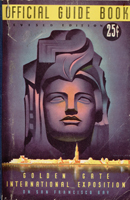
1. 1939: The Golden Gate Exposition on Treasure Island was the birthplace of KGEI.
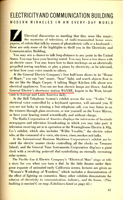
2. 1939: The guide shows that W6XBE was in the Electricity and Communications building (however, W6XBE did not broadcast to Europe, but to the Pacific).
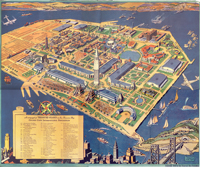
3. 1939: The guide provided a beautiful cartograph of the fair. KGEI was located in Building "C". (Note that the full image is 3 mb.)
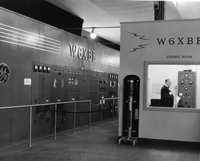
4a. 1939: The 50 kw transmitter on display at the Golden Gate Exposition on Treasure Island (before the call sign was changed to KGEI in August of that year).
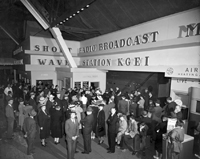
4b. 1939: A broader view of GE's radio exhibit with the change to "KGEI."
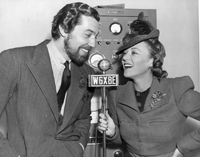
5. 1939: Hollywood stars Cesar Romero and Sally Eilers, broadcast greetings to Latin America from W6XBE (KGEI) at Treasure Island.
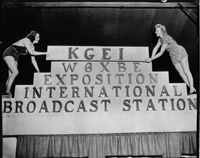
6. 1939: Folies Bergere dancers at the Golden Gate Exposition help publicize the name change to "KGEI."
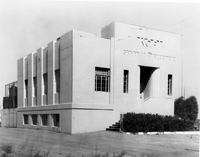
7. 1941: KGEI's reinforced concrete transmitter building near Belmont. Built to withstand bomb or earthquake.
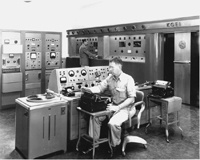
8. 1941: KGEI transmitter in the new building, outfitted with art deco trim.
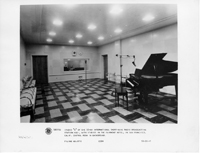
9. 1941: The studio in the Fairmont Hotel.
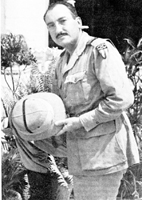
10. 1946: William Winter in the Philippines, to attend a state dinner given in his honor by President Manuel Roxas, for his KGEI broadcasts during the war.
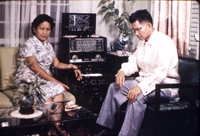
11. 1941-45: Philippine Consulate General Tiburcio Baja was KGEI's Filipino voice of encouragement during WW2. (Photo 1960, Manila)
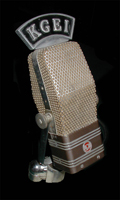
12. 1941-50: Classic RCA 44BX 1-4.
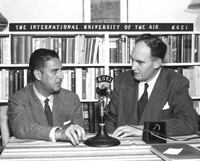
13. 1954-5: Noted Stanford professor Ronald Hilton (r.) conducted the International University of the Air.
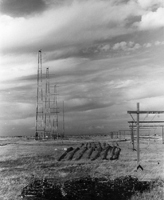
14. 1960: KGEI Antennas as originally constructed by GE. Note US Marine guard shack on far edge of the property, which appears through the lower left section of first tower.
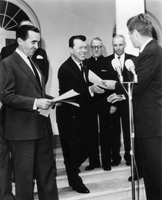
15. 1962: KGEI receives commendation from President Kennedy.
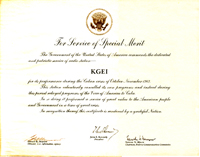
16. 1962: The award is signed by Kennedy, Murrow, Minow.
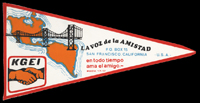
17. 1970s: Popular station giveaway: a banderín.

18. 1970s: Thousands of "Diplomas of Friendship" were sent to listeners participating in the "Chain of Friendship."
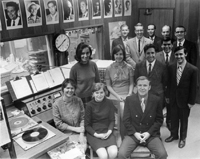
19. c. 1972: KGEI administrative, engineering and broadcasting staff. Listener photos on the wall reminded broadcasters who they were talking to.
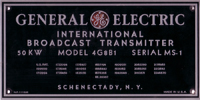
20. 1939-1995: The vintage GE 50 kw transmitter, with minor upgrades, performed flawlessly for 55 years.
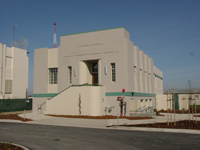
21. 2002: KGEI building, just-remodeled for a church office in Redwood Shores. Under the boards on the facade, embedded bas-relief in the concrete it still says: "KGEI - General Electric."
International Broadcast Station KGEI was established by General Electric Company in 1939, a high frequency (HF) short wave station known initially as W6XBE. The 50 kw transmitter was first located as an advanced technological display at the Golden Gate International Exposition on Treasure Island in San Francisco Bay (Images 1-4). Noted personalities, especially those known throughout the world, were invited to give greetings to the audience from the fair (Image 5). In August of 1939, the station's call sign was changed to KGEI (standing for "GE International"), and publicized with the help of Folies Bergere chorus girls (Image 6).
At the Exposition's conclusion, the transmitter was moved to the eastern tip of Redwood Peninsula (now Redwood City), about three miles east of Belmont , next door to KPO (eventually KNBC, now KNBR). The reinforced concrete building, with its 3-foot thick walls, ceilings and floors (typical of most major transmitter buildings of the wartime era), was built to address the possibility of bombing attacks (Images 7,8). On the Bay side of the property a Marine sentry shack was constructed to guard against amphibious incursions (Image 14). Even today, armed with a metal detector, .45 caliber bullets can be located and extracted from the silty dikes, where guards apparently took target practice during times of boredom.
GE's purpose for the station was to promote its products to the world. Its three "curtain" antennas for 19, 25 and 49 meters, were perfectly aligned (126/306 degrees) with the capitals of Latin America and Asia. In fact a perfectly straight line could (and still can) be drawn from Tokyo, San Francisco, Mexico City, Quito and Buenos Aires! In the days of relatively uncluttered HF bands, the 50 kw signal was heard with great clarity, virtually around the world. KGEI rebroadcast some features of KPO and KGO.
The wartime broadcasts were widely heard in the Philippines during the dark days of Japanese occupation, and played a historic role in the life of General Douglas Mac Arthur. As the Japanese invaders moved south from northern Luzon, US troops had been pushed down into the Bataan Peninsula and onto Corregidor Island in the mouth of Manila Bay. From his bunker in the Malinta tunnel on Corregidor, General Mac Arthur, along with his staff, listened to the daily news reports from KGEI, hoping to hear that the US government was gearing up to send reinforcements to rescue him and his outnumbered troops. Ordered by President Roosevelt to evacuate to Australia, Mac Arthur eventually made three speeches in Australia averring his commitment to return to the Philippines, summarized always in his famous promise: "I shall return." These speeches were relayed by KGEI back to the Pacific, and provided a rallying cry of encouragement to the Philippines and other occupied countries. MacArthur's subsequent speeches upon his return to the Philippines in October of 1944 ("I have returned"), were first broadcast on mobile short wave transmitters from a US Navy communications ship off Samar (Central Philippines), picked up in California and rebroadcast to Asia by KGEI and other short wave stations, which by now had been established by the Office of War Information (OWI) in the Bay Area (KWID, KGEX, KROJ).
Far East Broadcasting Company (FEBC) which eventually acquired KGEI, and which has operated stations in the Philippines from 1945 to the present, has met many former resistance fighters who listened to KGEI during that period. Now retired Philippine Ambassador Tiburcio Baja, a good friend of FEBC, was KGEI's Tagalog voice during Japanese occupation (Image 11) . Ambassador Baja tells of one group of Filipinos who would listen secretly for encouraging news regarding America's war progress in the evenings, and then dismantle the radio, each person taking with him a small piece of the set to hide during the daytime.
In 1954-55, Stanford University aired broadcasts to Latin America under the banner of "The International University of the Air," directed by noted Professor Ronald Hilton (Image 13). The program promoted better understanding among the peoples of the Americas, and boasted 12,000 letters received in a two year period.
Far East Broadcasting Company, a non-commercial, non-denominational Christian broadcasting organization, acquired KGEI in 1960. The station, along with its Christian broadcasts, focused initially on Latin America as "La Voz de la Amistad (The Voice of Friendship), and won awards from Latin American government and private agencies for its work to promote harmony among the nations of the [Latin American] "Continent." KGEI also received many commendations for its efforts to unite Bay Area Latin immigrants with their families during times of natural disaster in their home countries. The correspondence department regularly received hundreds of letters weekly from every country of Latin America, especially in response to its "Inglés por Radio" program. Listeners were encouraged to share correspondence with listeners from countries other than their own. A "Diploma de Amistad" (Diploma of Friendship) was issued to partipants who would agree to carry on such contacts with others (Image 18). The correspondence program was called "Cadena de la Amistad" (Chain of Friendship). News broadcasts were a major feature of the hourly format.
An interesting series of experiences for KGEI began in July of 1962 when a curious letter was received from a Cuban listener, detailing the exact positions and descriptions of Russian missile launching sites. Since nothing had yet appeared in the world press about any such threat, KGEI's parent organization decided to reproduce the letter, as a curiosity, in one of its fund-raising letters to the donors. It was then KGEI learned that the CIA was on the donor mailing list! The phone rang, a meeting was arranged. The agent implored KGEI to bring such letters to their attention before making them public! No similar letters were ever received.
But three months later, the phone would ring again! The call this time was from the White House, in the voice of Presidential Press Secretary Pierre Salinger, informing KGEI's station manager that "the President himself" was requesting use of the station (and the two other private SW stations) to rebroadcast VOA during the growing Cuban Missile Crisis. The request was made for the station to "volunteer" its services. The reaction of the KGEI staff was not positive, since great care had always been made to convince KGEI listeners that its voice was independent of government influence. However, while the phone conversation was still in progress, a phone company field repairman appeared at the front door with his work order to install a direct line from VOA headquarters via Langley, Virginia. Apparently Kennedy was not as idealistic about freedom of expression internationally as Roosevelt had been during World War II. His concern was undoubtedly over short wave station WINB in Red Lion, Pennsylvania (see above).
The station thus carried VOA broadcasts for three weeks during the Crisis. After the crisis had passed, and for its trouble, the station was invited to a special ceremony on the steps of the White House, where President John Kennedy, Edward R. Murrow and Newton Minow (FCC Chairman) presented certificates for "Service of Special Merit" to FEBC President Robert H. Bowman (Images 15,16). But it took many weeks and months to re-establish the audience.
Still, KGEI's philosophy was to exert a different kind of influence on its Latin American listeners through its Christian broadcasts. One example of this comes from an account given by a listener, who revealed he had been a guerilla fighter with the Marxist Shining Path movement in Peru. He related that he and his companions were required to listen to Radio Havana in the evenings. One night when he was listening alone in the jungle, he became depressed with the constant harangues and hate-filled complaints against "capitalist enemies" routinely broadcast from Havana. He moved the dial in frustration and by chance hit upon KGEI's evening broadcast, whose announcer was extolling, of all things, the virtues of forgiving one's enemies! The effect was apparently so soothing, that he continued to listen for a few evenings, whereupon he decided abandon his unit and flee back to the city, where he sought out a church. He eventually studied to be a pastor, and one of the final requirements for graduation from this particular Seminary, was to write a letter to the person or persons who had turned their life around. And thus KGEI received this amazing story.
One of KGEI's favorite accounts is that of a Guatemalan listener who had decided to kill his unfaithful wife and her lover.. He had tucked a pistol into his waistband and had headed out to his motorbike. Discovering that he had forgotten the keys, he rushed back into the house, just in time to hear the words come out of his radio "Are you thinking about doing something really stupid?" It turns out the KGEI announcer was warning listeners that bad things will get worse if one tries to solve problems without help from God. The man figured it God was trying to talk to him, and so he put the gun away. The story has a very happy ending, for after some continued listening and meditation, he became convinced that he himself was the problem in the marriage, reformed, and won his wife back!
One of the responsibilities (or in some cases, liabilities) of international radio stations is to provide "QSL" (Confirmation of Reception) cards to "DXers" (listeners who log the world's stations as a hobby). KGEI routinely provided thousands of the cards, especially to Japanese listeners who were especially fanatical DXers. Insight into the fierce competition to log the most stations was revealed after 1994 when the station was closed down, as FEBC continued to receive reception reports from Japan! Apparently some listeners had been "logging onto" outdated editions of World Radio and TV Handbook!
FEBC, with no buyers on the horizon, reluctantly closed the station in July of 1994, in order to focus on its broadcasting efforts within Asia. The vintage GE 50 kw transmitter was donated to Christian missionary organization SIM, Inc. (minus the historic ID plate!(Image 20)) for use in Monrovia, Liberia. Shortly after its installation there, a rebel attack destroyed the transmitter altogether. The 250 kw transmitter was donated to Project Aurora, another Christian outreach ministry, for use in broadcasting to Russia from Alaska. The property and the building was sold to Redwood Shores' Fully Alive Community Church, who beautifully remodeled the building for an administration office, and which can be visited today (image 21).
There is one final story to tell. In 2002, when the church was struggling to complete the remodeling of the KGEI building, they were informed that all available phone lines had already been assigned to Redwood Shores businesses and residents. A new trunk would have to be run at a cost of $20,000, which the small congregation wasn't prepared for. But with no other choice for phone service, the work was ordered. Fortunately, when the work order passed by the desk of a former field repairman at the phone company, he thought he knew where there might be an extra line. A closer examination of the appropriate control panel revealed an unmarked pair, which when tested, ran directly to Langley, Virginia. The line installed from KGEI to VOA during the Cuban Missile Crisis forty years previously, had never been disconnected! It seems that the Russian and Cuban Marxists had indirectly and unwittingly provided a phone line for a church!
Send Comments/Corrections/Additions Additional KGEI photos (use keyword "KGEI")«